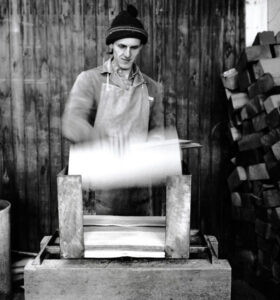All densely wooded areas around the world have been familiar with the timber shingle since the establishment of their earliest settlements. As there were no nails, the shingles were simply placed on the roof and weighted down by bars and stones. The so-called „laid shingle“ is the oldest type of shingle and can still be found in the Alpine region. These shingles were always split by hand. Spruce and larch wood were mainly used in the Alpine region, oak and hornbeam in Central Germany and oak in the coastal area of Northern Germany.
The Indians in North America used Western red cedar. Even with the later introduction of machine sawn shingles, hand split shingles still continued to be used. Whilst the cut made by a saw always runs more or less at an angle to the direction of the grain and therefore cuts through the longitudinal fibres, splitting separates the wood along the grain, thereby keeping it intact along the entire length of the shingle.
Many civic chronicles document that in the later Middle Ages almost all houses both in the towns and the countryside had a wood shingle roof. Only when the right of use for the woodland was transferred to the landowner alone and people were required to pay for the timber they needed, did the number of houses with shingle roofs diminish. Improved transport opportunities and the industrial production of other roofing materials also contributed to the further changes which took place in the roofing sector.

